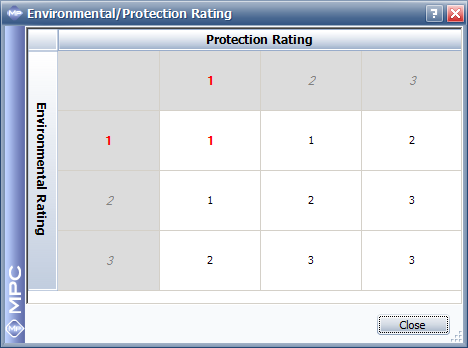![]()
![]()
| Related Topics: | ||

You can perform environmental deterioration (ED) analysis for any structural item that has been marked as a structural significant item (SSI). The rating system varies depending on whether the materials are metallic or non-metallic, but both ED analyses tabs function in a similar manner. This topic describes how to use either tab. This includes:
How to add or delete an ED analysis for an SSI.
How to use the ED analysis tab to evaluate materials and assign necessary structural analysis inspections.
A discussion of the rating systems used for metallic materials and non-metallic materials.
Note that these rating systems are configurable at the database level. (See Configurable Options for Structural Analysis.)
To add a new ED analysis tab, select an SSI in the structural hierarchy and choose Structures > Analyses > [Add ED (Metals)/Add ED (Non-Metals)].
![]()
![]()
To delete an analysis, select a tab in the Analysis panel and then choose Structures > Analyses > Delete Analysis. (Remember there is no undo for delete.)
![]()
The top section of the ED analysis tab allows you to perform a separate evaluation for each material that the structural item is composed of.
To add a new material evaluation, choose Structures > Materials > Add New Material.
![]()
To view or edit the complete evaluation for one of the materials in the list, select the row and double-click or choose Structures > Materials > Edit Material.
![]()
Tip: If want to copy or link to a material evaluation that has already been performed for another SSI, choose Structures > Materials > Add Existing Materials. (See Select Existing Materials.)
The evaluation criteria displayed in the Materials Properties window will vary depending on whether the material is metallic or non-metallic. Furthermore, these rating systems are configurable at the database level. (See Configurable Options for Structural Analysis.)
The middle section of the ED analysis tab displays the combined results from all of the materials that were analyzed.
Each combined rating will be the worst rating that has been assigned to any of the materials. For example, if there are two materials and one has a Protection rating of 3 - Special but the other has a rating of 1 - Limited, the worst rating (limited protection) will be used for the combined analysis.
For each overall rating, you can click the ![]() icon
to see the matrix that was used to determine the score. For example, the
Environmental/Protection score reflects the adversity (or corrosiveness)
of the environment balanced against the degree to which the structural
item is protected from that environment. The following picture shows the
default matrix used to obtain this score. In this case, the item is exposed
to an adverse (or corrosive) environment (Environmental Rating = 1) and
has limited protection from the environment (Protection Rating = 1), resulting
in the worst possible overall score of 1.
icon
to see the matrix that was used to determine the score. For example, the
Environmental/Protection score reflects the adversity (or corrosiveness)
of the environment balanced against the degree to which the structural
item is protected from that environment. The following picture shows the
default matrix used to obtain this score. In this case, the item is exposed
to an adverse (or corrosive) environment (Environmental Rating = 1) and
has limited protection from the environment (Protection Rating = 1), resulting
in the worst possible overall score of 1.

The bottom section of the ED analysis tab allows you to define any maintenance tasks that are recommended based on the environmental deterioration analysis.
To add a new task, choose Structures > Tasks > Add Task.
![]()
To view or edit the properties of an existing task, select the row and double-click or choose Structures > Tasks > Edit Task.
![]()
For information about the task properties, see Structural Analysis Tasks.
For metallic materials, the evaluation considers:
Corrosion
Potential Corrosion: A set of ratings are used to classify the material's sensitivity to a list of potential corrosion types (e.g., pitting, erosion, etc.). The PCT Rating for the material will be the worst rating that has been assigned to any of the corrosion types.
Stress Corrosion Cracking: A single SCC Rating classifies the material's sensitivity to stress corrosion cracking.
The Overall Corrosion score is assigned based on a scoring matrix that considers the PCT Rating and the SCC Rating.
Note: If the material does not have an SCC rating defined, then its Overall Corrosion score is the same as its PCT Rating.
Environmental and Protection
Environmental: A single rating classifies the materials potential exposure to corrosive substances.
Protection: A single rating classifies the degree to which the material might be protected from damage due to exposure to corrosive substances.
The Environmental/Protection rating is based on a scoring matrix that considers the Environmental rating and Protection rating.
The Overall score is assigned based on a scoring matrix that considers the Overall Corrosion score and the Environmental/Protection score.
For non-metallic materials, the evaluation considers:
Damage
Potential Damage: A set of ratings are used to classify the material's sensitivity to a list of potential sources of environmental damage (e.g., humidity, lightning, etc.). The overall PD Rating for the material will be the worst rating that has been assigned to any of the sources.
Damage Detectability: A single DDR Rating classifies the likelihood that environmental damage will be detected.
The Overall Damage score is assigned based on a scoring matrix that considers the PD Rating and the DDR Rating.
Environmental and Protection
Environmental: A single rating classifies the materials' potential exposure to an adverse environment.
Protection: A single rating classifies the degree to which the materials might be protected from damage due to exposure to an adverse environment.
The overall Environmental/Protection rating is assigned based on a scoring matrix that considers the Environmental rating and Protection rating.
The Overall score is assigned based on a scoring matrix that considers the Overall Damage score and the Environmental/Protection score.
© 1992-2015. ReliaSoft Corporation. ALL RIGHTS RESERVED.